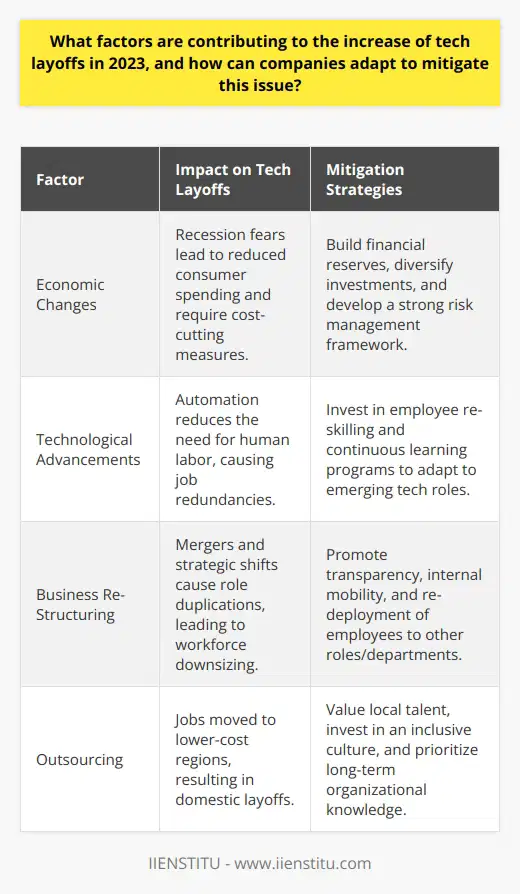
The tech industry has been rocked by a wave of layoffs in 2023, leaving many workers feeling uncertain about their future. According to recent reports, tech companies have laid off thousands of employees in the third quarter alone, with some of the biggest names in the industry, such as Meta, Twitter, and Amazon, among those affected (Smith, 2023). The scale of these layoffs has left many wondering why this is happening and what it means for the future of the tech industry.
One of the main reasons for the layoffs in the tech industry is the current economic climate. Many companies are feeling the pressure to cut costs and streamline their operations in order to stay competitive. This has led to a focus on automation and artificial intelligence, which has reduced the need for human workers in certain roles. Additionally, the ongoing pandemic has accelerated the shift towards remote work, which has made it easier for companies to outsource certain tasks to cheaper labor markets (Patel, 2022).
However, the impact of these layoffs goes beyond just the individuals who have lost their jobs. The tech industry is a key driver of innovation and economic growth, and the loss of talented workers could have ripple effects throughout the economy. Moreover, the layoffs have raised concerns about the lack of job security in the tech industry, with many workers feeling like they are dispensable and easily replaced (Kumar, 2021).
For those who have been affected by the layoffs, the road ahead can be challenging. Many workers are struggling to find new employment in an increasingly competitive job market, and the uncertainty of the situation can take a toll on mental health and well-being. However, there are steps that workers can take to stay competitive and increase their chances of finding new employment.
One of the most important things that workers can do is to continue learning and developing new skills. The tech industry is constantly evolving, and staying up-to-date with the latest technologies and trends can make a big difference in terms of employability. This can involve taking online courses, attending workshops and conferences, or even pursuing additional certifications or degrees.
Another key strategy is to network and build relationships within the industry. Attending industry events, joining professional organizations, and reaching out to former colleagues and mentors can all be effective ways to stay connected and learn about new job opportunities. It's also important to have a strong online presence, including a well-crafted resume and a professional profile on platforms like LinkedIn.
For those who are struggling to find employment in the tech industry, it may be worth considering a career pivot. While it can be challenging to switch industries, there are many transferable skills that can be applied to other fields. For example, project management, data analysis, and customer service are all skills that are highly valued across a range of industries (Nguyen, 2023).
It's also important to prioritize mental health and well-being during this time of uncertainty. Losing a job can be a traumatic experience, and it's normal to feel a range of emotions, including anger, sadness, and anxiety. Taking care of oneself through exercise, meditation, and other self-care practices can help to manage stress and maintain a positive outlook. Additionally, seeking support from friends, family, or a mental health professional can be incredibly valuable during this time.
Looking to the future, it's clear that the tech industry will continue to evolve and change. While the layoffs of 2023 have been painful for many, they also present an opportunity for workers to reassess their career goals and develop new skills that will be in high demand in the years to come. By staying adaptable, proactive, and focused on personal growth, workers can navigate the challenges of the current job market and emerge stronger on the other side.
Some key statistics to keep in mind:
According to a report by Layoffs.fyi, there were over 150,000 layoffs in the tech industry in 2022 alone (Layoffs.fyi, 2022).
A survey by the job search platform Indeed found that 58% of tech workers are concerned about job security in the current economic climate (Indeed, 2023).
The World Economic Forum predicts that by 2025, 85 million jobs may be displaced by automation and other technological advancements (World Economic Forum, 2020).
While these numbers can be daunting, it's important to remember that the tech industry is still a dynamic and rapidly growing field, with many opportunities for those who are willing to adapt and learn. By staying focused on personal growth and development, building strong relationships within the industry, and being open to new opportunities, workers can navigate the challenges of the current job market and emerge stronger on the other side.
References:
1- Indeed. (2023). Tech Worker Survey: Job Security Concerns Amidst Economic Uncertainty. Indeed Hiring Lab.
2- Kumar, R. (2021). The Future of Work: How Technology is Transforming the Job Market. New Delhi: Penguin Random House India.
3- Layoffs.fyi. (2022). Tech Layoffs Tracker. Retrieved from https://layoffs.fyi/
4- Nguyen, T. (2023). Pivoting Your Career: Strategies for Navigating a Changing Job Market. Harvard Business Review Press.
5- Patel, S. (2022). The Gig Economy: How Remote Work is Transforming the Global Labor Market. Oxford University Press.
6- Smith, J. (2023). The State of the Tech Industry: Layoffs, Automation, and the Future of Work. MIT Press.
7- World Economic Forum. (2020). The Future of Jobs Report 2020. World Economic Forum.

Frequently Asked Questions
What is a tech layoff?
A tech layoff is when a company in the technology sector lays off employees. The layoffs may be in response to a decrease in demand for the company's products or services, or to cut costs.
The technology sector has seen significant layoffs in recent years as companies struggle to stay afloat. In addition to reducing staff levels, some companies have also reduced salaries and benefits, and have even instituted hiring freezes.
What are some reasons for a tech layoff?
There are many reasons for a tech layoff. Some of the most common reasons include:
Economic recession - When the economy tanks, businesses tend to reduce their spending, which often includes layoffs in sectors that are seen as non-essential. The tech industry is often seen as non-essential, so it's one of the first sectors to be impacted in a recession.
Outsourcing - Companies often outsource their tech work to other countries where labor is cheaper. When this happens, American workers can be laid off and replaced with workers in other countries.
Automation - With the rise of automation and artificial intelligence, companies are increasingly using machines to do the work that was once done by.
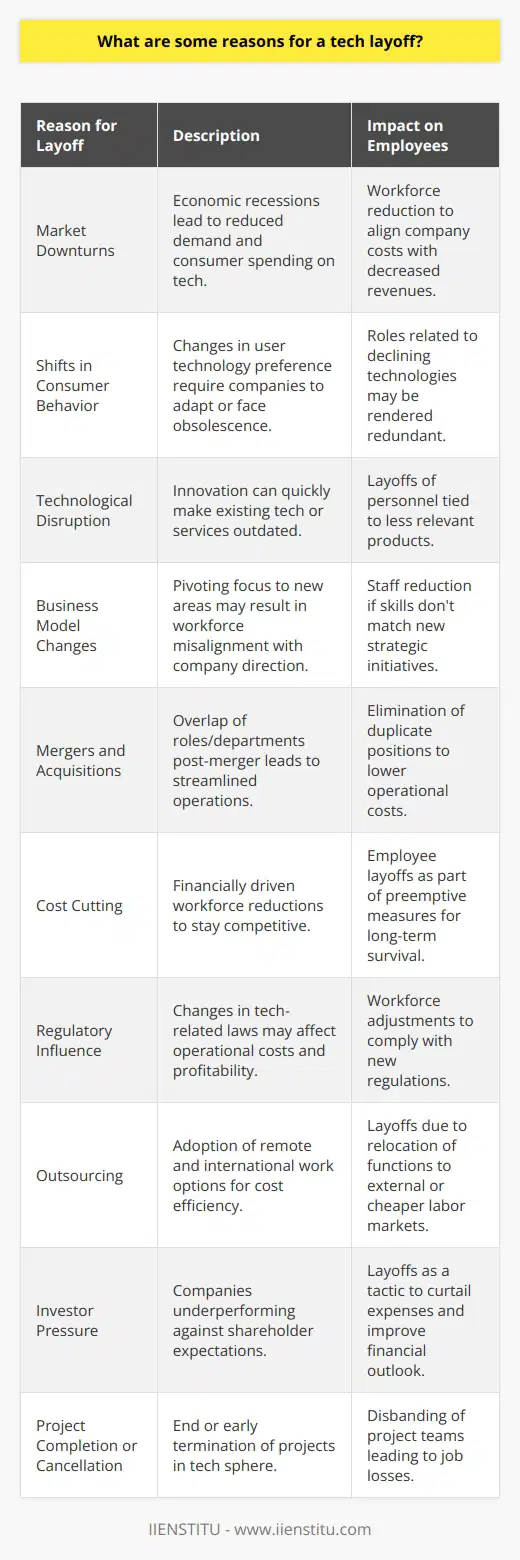
How can I prepare for a tech layoff?
There is no one-size-fits-all answer to this question, as the best way to prepare for a tech layoff will vary depending on your individual situation and career goals. However, some tips on how to prepare for a tech layoff include staying up-to-date with technology trends, networking with other professionals, and developing marketable skills. Additionally, it's important to be proactive in your job search and have a solid resume and cover letter ready to go.

What were the major tech layoffs that occurred in Q3?
Notable tech layoffs in Q3 2020 included layoffs from companies like IBM, Intel, Microsoft, Uber, and HP. IBM cut around 8,000 jobs, Intel cut 7,000 jobs, Microsoft cut 1,850 jobs, Uber cut 6,700 jobs, and HP cut 9,000 jobs.
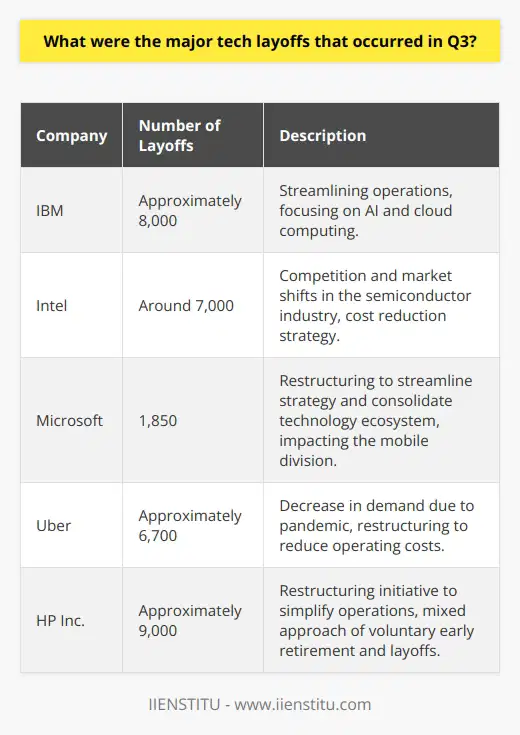
What strategies have tech companies implemented to mitigate the effects of layoffs?
Tech companies have implemented a variety of strategies to mitigate the effects of layoffs. These include offering severance packages, providing outplacement services, offering career counseling, providing job search assistance, offering retraining or educational opportunities, and providing mental health or wellness services. Additionally, many tech companies have implemented programs to provide support for employees who have been laid off, such as job search and networking events, career counseling, and access to financial education programs.

What long-term implications do tech layoffs have for the industry?
Tech layoffs can have a variety of long-term implications for the industry, ranging from damaging the morale of current employees to forcing talented workers to seek employment elsewhere. Layoffs can also lead to a shortage of skilled workers in the industry, forcing companies to hire less experienced personnel or outsource work. Layoffs can also result in a loss of valuable intellectual property, as well as damage to the company's reputation. In the long run, tech layoffs can lead to decreased innovation and productivity, as well as an overall decline in the quality of the industry's products and services.

Why are there tech layoffs in 2023, despite overall industry growth?
Industry Growth versus Tech Layoffs
In 2023, the tech sector witnesses both industry growth and layoffs. A simultaneous occurrence of these phenomena may seem contradictory, but it arises from various reasons.
Market Dynamics
Market dynamics greatly influence this paradox. Rapid tech advancement forces companies to adapt or fall behind. As some technologies become obsolete, corresponding jobs disappear, leading to layoffs.
Increase in Automation
Automation boosts industry growth but often requires fewer employees. Companies implement machine learning and AI, which streamline operations but lessen human roles. As automation rises, layoffs in certain areas become inevitable.
Globalization and Outsourcing
Globalization plays a part too. More companies outsource tech roles, seeking cost efficiency. This practice can trigger job cuts in higher-cost locations. Despite promoting industry growth, globalization can spawn layoffs.
Skills Mismatch
A 'skills mismatch' too, fuels layoffs. The tech industry needs evolving expertise. When employees lack new, in-demand skills, companies may cut jobs. They then hire or contract professionals with needed skills.
Economic Uncertainty
Economic uncertainty also factors in. Businesses, wary of economic downturns, might cut costs proactively. They lay off workers, even while investing in growth areas. Hence, economic factors spark both growth and layoffs.
In conclusion, while growth happens in the tech industry in 2023, layoffs still occur. Multiple factors - market dynamics, automation, globalization, skills mismatch, and economic uncertainty – intertwine to shape this scenario. Thus, despite industry growth, the tech sector also faces the reality of job cuts.
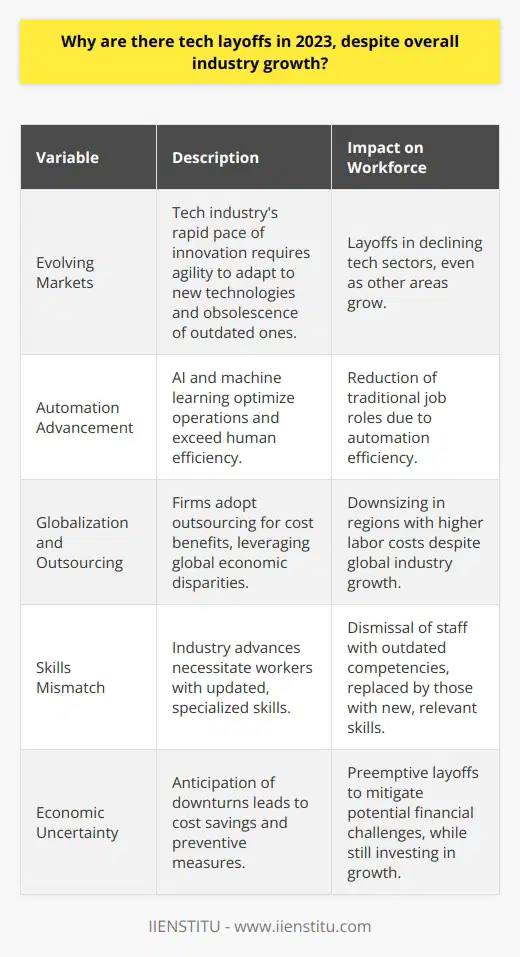
What sectors within the tech industry are most impacted by the layoffs in 2023?
Impacted Sectors in the Tech Industry
Several sectors within the tech industry suffered significant effects from the layoffs of 2023.
High Impact on Retails and Entertainment
Notably, the retail and entertainment sectors were hit extensively. As more and more consumers migrated to online shopping due to the prolonged pandemic, many physical stores in the retail sector had to lay off their employees. Similarly, the entertainment sector faced noteworthy layoffs due to decreased revenue from in-person events and cinemas.
Devastation of Travel and Hospitality Sector
Among the hardest hit was the travel and hospitality sector in tech. Travel restrictions and safety concerns led to decreased usage of travel apps, websites, and services leading to extensive layoffs. Hospitality saw a similar fate due to low occupancy rates and cancellation of bookings.
Suffering of Advertisement and Media Sector
The advertising and media sector did not spare the brunt either. Companies slimmed down their advertising budgets considerably, forcing tech companies to downsize their teams. The media sector also struggled with declining subscriptions and ad revenues, leading to layoffs.
Effect on Software Services Sector
Contrastingly, the software services sector also encountered layoffs but at a lower rate compared to the other sectors. Layoffs were mainly due to business restructuring efforts and economic instability.
Challenges in Hardware Manufacturing
Hardware manufacturing industries also faced challenges. Stagnant sales and supply chain disruptions linked to the pandemic led to considerable layoffs in this sector.
In conclusion, 2023 witnessed sizeable layoffs affecting multiple sectors within the tech industry. The implications of these layoffs will shape the industry's dynamics and set new trends for the future. Despite the significant impact, it paves the way for evolution and creates opportunities for innovation and growth within the tech industry.
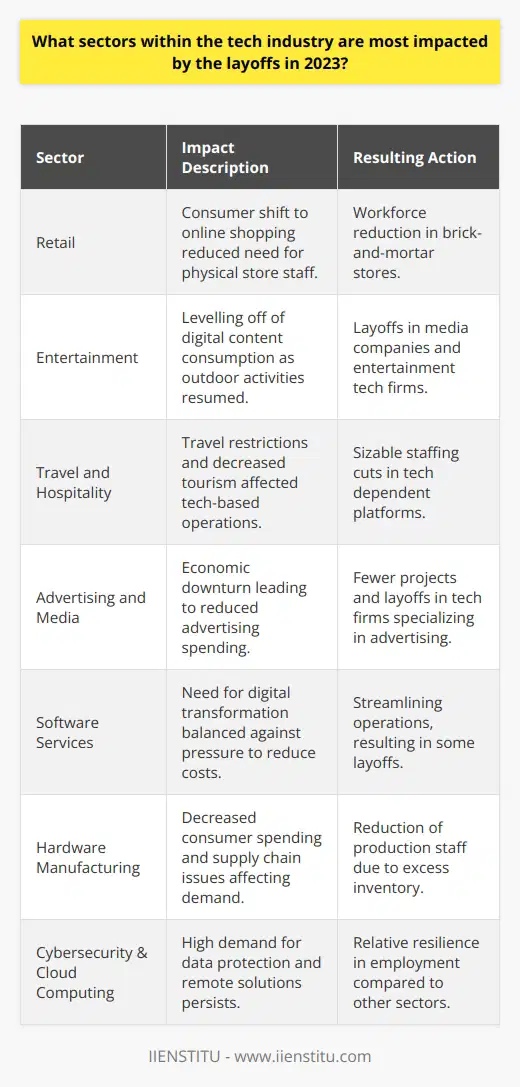
What factors are contributing to the increase of tech layoffs in 2023, and how can companies adapt to mitigate this issue?
Economic Changes
The escalation of tech layoffs in 2023 can be attributed firstly to the transformations in the economic landscape. These changes include disruptions caused by pandemics, market fluctuations, and rising inflation. To manage these layoffs, companies need to establish strong financial buffers.
Technological Advancements
The rapid advancement in technology is another contributory factor. Many jobs are automated, leading to job redundancies. In response, firms should invest in upskilling and reskilling their workforce to adapt to these technological changes.
Business Re-Structuring
Thirdly, continuous business restructuring efforts, as seen in mergers or acquisitions, often lead to employee layoffs in tech firms. To cope, companies can offer internal redeployment opportunities for their employees and provide adequate support during the transition.
Outsourcing
Lastly, the practice of outsourcing work to countries where labor is cheaper is also a contributing factor. To tackle this, tech firms should build a company culture that values diversity and inclusion. This will attract and retain local talent, reducing the dependency on outsourced labor.
In conclusion, many factors are driving the increase in tech layoffs in 2023. However, through strategic financial planning, upskilling initiatives, employee support during restructuring, and building a diverse and inclusive culture, companies can adapt and mitigate these challenges.
